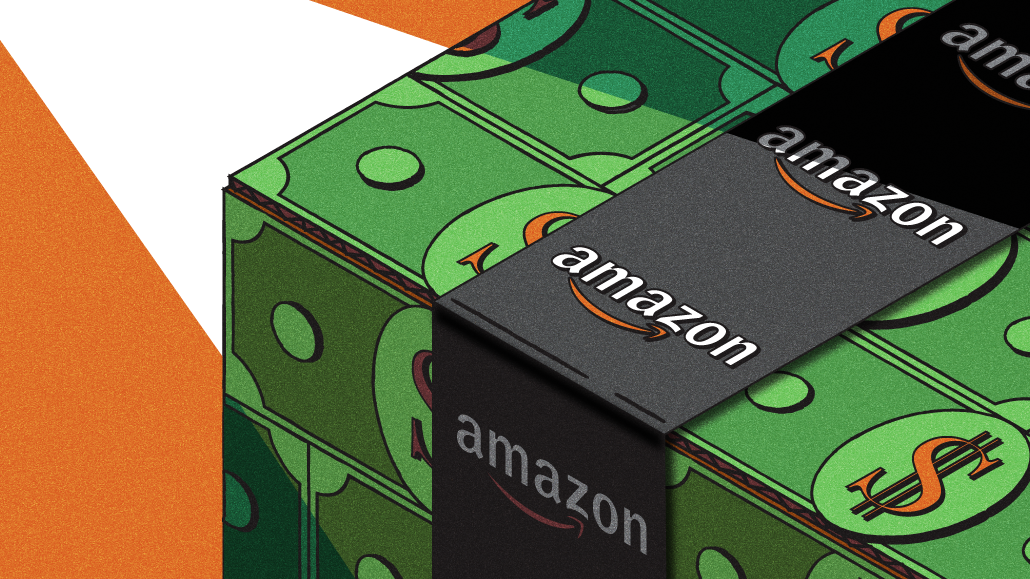
Amazon may not be the go-to for programmatic ad buys. But with each passing quarter, that assumption is looking shakier.
Just look at its latest earnings: $17.3 billion in ad revenue, a 17% jump from the same period last year. Driving that growth is the Amazon Demand-Side Platform (DSP), which lets advertisers tap into its rich data to buy ads both within its walled garden and beyond.
While that premise isn’t new — it’s been pitched as a full-scale programmatic solution for years. But a steady stream of updates, partnerships and strategic moves has made it more compelling than ever.
Tinuiti’s clients are a case in point. Their spending on Prime Video ads has surged over the past year, with Q4 ad spending more than eight times what it was in the first quarter of 2024.
While advertisers don’t have to use Amazon’s DSP for these buys, many do. The share of Prime Video ad spending through the DSP jumped from 26% in the third quarter to 36% in the fourth quarter last year. But the DSP isn’t just becoming the preferred way to buy Prime Video ads – it’s becoming the dominant way advertisers spend on Amazon, period. By the fourth quarter of 2024, advertisers using the DSP accounted for 32% of all Amazon ad spend.
Clients at Pacvue have a similar view. Last year, they posted higher average daily spending on both quarter over quarter (+20.52%) and year over year (+16.63%). While ROAS decreased over the same period, the decline was negligible at -0.42% and effectively balanced out by a 1.63% quarter-over-quarter improvement.
It’s still early to call how this year will shake out, but so far, the momentum is holding strong.
“I would assume we’ll see similar growth in spending on the Amazon DSP this year compared to last, especially in Europe where we’re seeing interest from advertisers and agencies who are new to the tech,” said Clare Hogan, head of retailer partnerships at Pacvue. “Part of that comes down to the fact that Amazon has removed the barrier of entry to the DSP. If you don’t hit the minimum spend thresholds to be able to use the DSP direct now you can go through a reseller.”
Even smaller advertisers are leaning into the Amazon DSP in a way that’s harder to ignore.
As Robert Kurtz, group vp of search media solutions at Basis Technologies, explained: “Amazon DSP is a very small percent of where our clients want to allocate ad dollars (high six figures total in spend in all of 2024). However, in just one month of 2025, one client has spent nearly the equivalent of all our Basis 2024 spend on Amazon DSP. So it is already outpacing last year.”
Expect more of these shifts as the year unfolds, particularly from marketers who haven’t traditionally gone all-in on Amazon. The DSP is becoming harder to resist, and for good reason. It’s cheaper than larger DSPs, comes with slimmer tech fees and Amazon is pulling out all the stops to position it as a full-scale programmatic solution – not just a way to buy ads within its own walls.
Which is to say, it’s becoming a way to access some of the most valuable real estate outside the largest platforms. And It’s why Amazon is working with programmatic marketplace operators to secure top-tier inventory and why it’s expanding access to premium streaming placements.
That last move is especially significant for marketers since it means they can now buy more streaming ads across platforms like Disney+, Paramount+ and Max using the same targeting and measurement tools they rely on for Amazon’s own premium TV inventory including Prime Video.
“For our clients prioritizing OTT/CTV placement, the percentage of spend has remained similar to last year, hovering around 15% of marketing spend, with an overall increase in marketing budget,” said Chris Matheson, media manager at digital ad agency Markacy. “However, we’re noticing a shift within that 15%, with more of the spend moving toward Amazon DSP. Last year, it was around 2%-5%, and this year, we’re seeing that increase to 3%-8%.”
Bit by bit, Amazon is putting a question in front of its advertisers, especially those already selling on its marketplace. If the DSP can offer a more diversified, data-rich way to buy streaming ads, why go elsewhere?
The platform’s evolution backs up the pitch. Amazon Publisher Cloud has strengthened its supply-side tech through partnerships with major publishers. Key deals with ad tech firms like Magnite have further expanded its reach. Meanwhile, the supply deal desk has built a steady stream of always-on private marketplace deals, allowing marketers to secure premium inventory and audiences at locked-in prices. The result is a DSP with access to some of the most sought-after TV inventory, all within Amazon’s growing ecosystem.
Great as the numbers and anecdotes are, the DSP still has a long way to go before its ambitions of becoming the place advertisers go to spend most (if not all) of their digital ad dollars. It still trails its larger rivals, and its growth isn’t necessarily coming at their expense most of the time.
Sure, that could change for all the aforementioned reasons but there are still some deeper issues Amazon needs to address, like the ongoing challenge of proving the DSP’s incremental value compared to its more established search ads.
“Amazon DSP for our brands is typically 10-15% of spend once they have maximized sponsored search spend – typically that holds flat as it’s hard to prove out incrementally often,” said Shray Joshi, founder and CEO of Good Peeps. “The thing is Amazon gets so much search volume that often you’re better off spending on sponsored search at a lower ROAS on more upper funnel keywords vs. just spending on upper funnel DSP for the sake of it.”
Amazon is well aware of this. It’s part of the reason the company has been working with ad tech firms like TripleLift and YieldMo to address the issue.
Joshi expanded on the point: “While the ad tech helps overall brand halo we have found that you can always track the dollar impact on search ads and brands tend to put their money in places where they can directly track ROI.”
In short, the Amazon DSP remains a crucial gear in an ad machine that’s running more smoothly than ever. Last year, that machine hit a $69 billion annual run rate – and it’s only accelerating, judging by the enthusiasm from marketers and media buyers. Still, there’s a long road ahead before it becomes the primary DSP for a significant chunk of the ad industry.
More in Marketing

Pandora is betting on AI agents to scale service and emotional selling during the peak holiday season
Pandora is using AI agents to scale customer service and replicate emotional in-store selling online, just as peak season puts pressure on margins and teams.

Rembrand’s CEO wants to grow virtual ad placements in streaming, and he’s looking elsewhere for models
Omar Tawakol wants to improve advertising within the streaming world, and is working with advertisers and publishers to improve that experience.

Marketers are keen to use generative AI in ad campaigns, but hidden costs lurk
Marketers across the industry want to use AI to cut down on time spent in creative production. It’s not so simple in practice.








